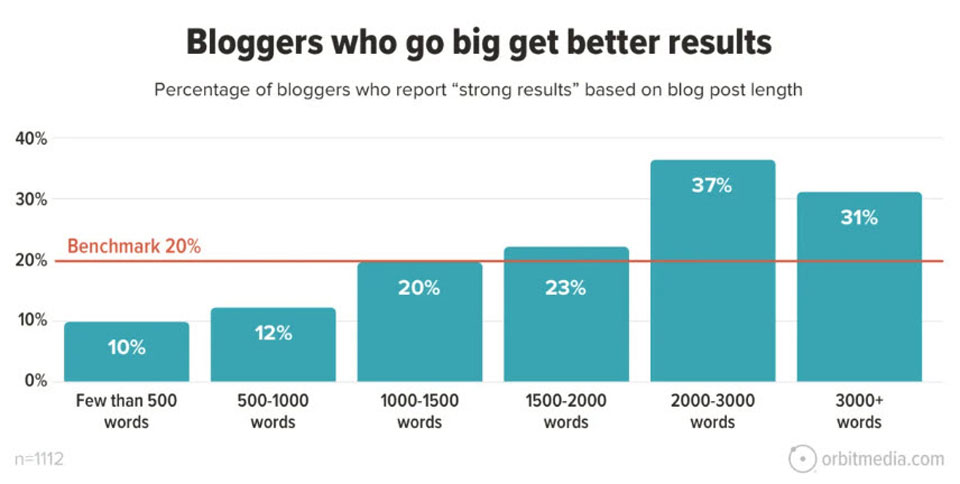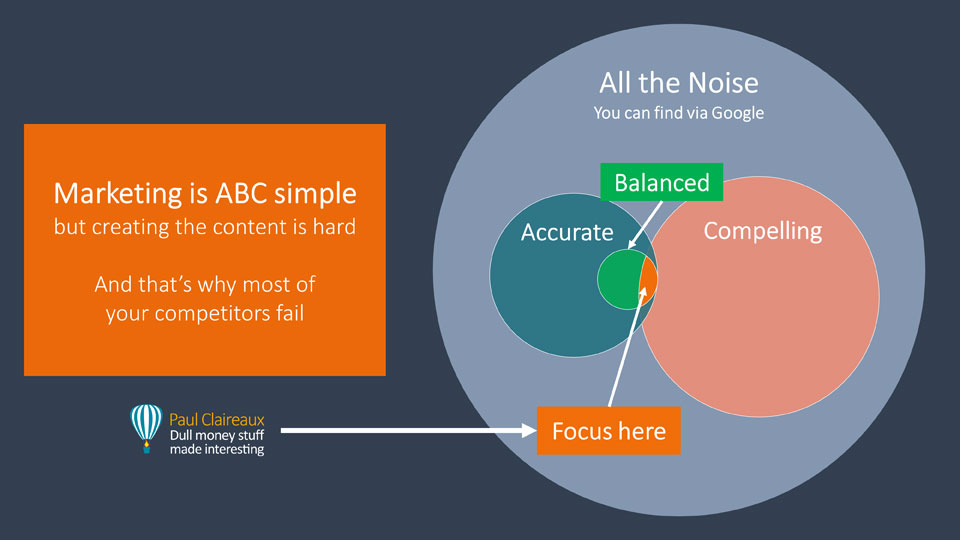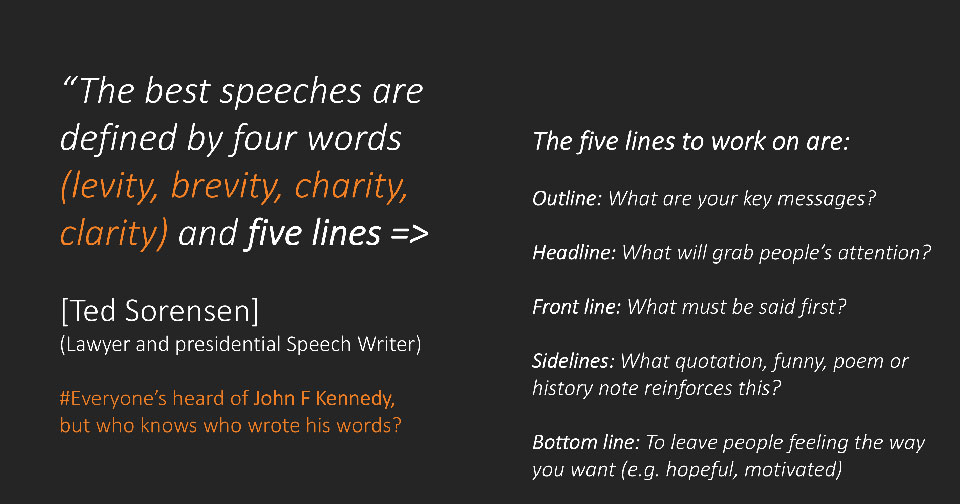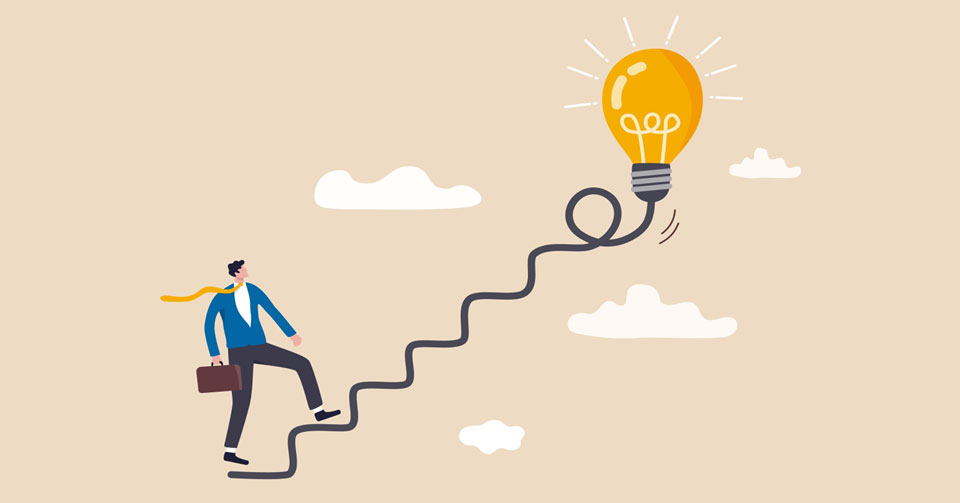Seven questions to ask any content supplier
to ensure you have content that boosts (and doesn't damage) your reputation

This page is for YOU if you run a financial advice, planning or coaching firm and you use (or plan to use) licensable educational content in your business.
This is an expanded set of user notes!
Once you purchase a license to use any of our consumer-facing Insights, you’ll immediately receive a link to download the text and image files.
You’ll also receive some notes on the various ways you could use the content – and how you’ll want to adjust it before loading it to your website.
Here, I’ll expand on those notes to cover seven questions I think it’s worth asking about any content you plan to use.
You can jump to any section from the links here:
- Will this content deliver real benefits to your business?
- What is the quality and value-for-money of this content?
- How many ways could you use the content?
- Do you offer deep-dive content – or just tidbits?
- How do you slice short-form posts from long-form content?
- How do you prepare the content for your website?
- How do you load the content to your website?
Financial planners tell me this post answers most of their questions, but if you have others, please e-mail me at hello@paulclaireaux.com, and I’ll get back to you as soon as I can.
Will this content deliver real benefits to your business?
Those of us who have worked as or in support of financial planners for some time know that clients value Insights into their money questions more than anything else.
So, good quality, consumer-facing educational content will, of course, enhance your firm’s reputation.
However, in working with my clients over the years, I’ve identified 25 benefits (to firms and consumers) of an education-first approach to marketing.
And if you e-mail hello@paulclaireaux.com with the message, ‘Send me the 25 benefits’, I’ll send you a pack listing all those.
My financial planner friends tell me this is the most helpful document I offer, as it helps you make a business case (for education first marketing) if you need one of those.
Of course, we cannot enjoy any of those 25 benefits unless we offer great content.
So, I urge you to avoid those ghastly, glossy, but misleading sales aids supplied by some content firms (and fund managers!) that could damage your reputation.
We must reject the rest – and choose the best!
And please choose your content partners carefully.
What is the quality and value-for-money of this content?
This table and Venn diagram will help you with these questions.
In terms of value for money, ask this.
Will the content you plan to use save you 90% to 95% (or more!) of the cost of creating similar quality content in-house?
And does this content come with free updates – or do you have to purchase the updated version every year?
In terms of quality, ask this.
Does the content you’re looking at pass all three of those ABC tests?
We all want to differentiate ourselves from those offering mindless and misleading ideas.
So, please be sure the content you choose passes these tests.
Does the content seriously deserve people’s trust?
How much of the content issued by financial service firms (of any sort) do you believe passes all three of those ABC tests?
What percentage answer would your clients and potential clients give to that question?
Most people I ask give a very low percentage.
And the lowest percentages come from those who work – or have worked – in financial services.
So, we all know that building more trust with consumers means substantially improving the quality of ideas we share.
What’s my quality commitment to you?
My commitment is to work extremely hard to create ABC (accurate, balanced and compelling) consumer-facing Insights.
I’ve arranged for one of the UK’s leading financial planners to check this content for integrity – before I make it available for licensing.
And the Money Mindset insights (coming soon) are being checked by a Doctor of Psychology with 20 years of clinical experience.
Of course, you must still check that any content you license will:
- Serve the purpose you need it for.
- Comply with any regulations you’re bound by. (Compliance managers’ views vary, right?)
- Be removed from public display if it becomes outdated or no longer compliant.
I would be surprised if you find any quality issues with the content we supply. But please let me know if you do, and I’ll correct it immediately.
And head over here to see what licensable content I offer now – and what’s coming soon!
How many ways could you use the content?
My licensed Insights will help you equip your readers to make better money decisions – and signpost the many areas where professional advice or guidance could add value to their financial lives.
Your license agreement permits you to use the content:
- To build your firm’s reputation as a go-to place for answers to vital money questions.
- To attract, engage and retain more clients.
- To promote your services to other professionals and encourage referral business.
- For in-house training to encourage your team to use plain English, consumer-friendly, and consistent descriptions of financial concepts.
- In presentations to your clients and prospects to better prepare them for advice.
- To inform and complement descriptions of financial concepts in your client reports.
You are also free to:
- Apply your firm’s formatting style, colours, logo, etc.
- Remove or change the images if needed – provided this does not corrupt the messages. Just be aware that ‘in-post’ images significantly boost engagement.
- Add any regulatory warnings necessary – bearing in mind these are not financial promotions.
- Add your own ‘call to action’ messages to direct readers to seek your help in your preferred way – via telephone, e-mail, chatbot, or enquiry form.
- Produce the Insights in multiple formats: blog posts, presentation slide decks, videos, or PDF guides as downloadable lead magnets.
You can also use sections of these Insights to create a campaign series of ‘outreach’ posts on social media to draw people to your website.
And you may find it helpful to explore this idea in more depth.
Do you offer deep-dive content – or just tidbits?
 I’ll cover how you can slice long-form content into short (attention-grabbing) posts in a moment.
I’ll cover how you can slice long-form content into short (attention-grabbing) posts in a moment.
Frankly, that’s the easy bit.
First, however, you must decide whether to offer any deep-dive Insights – because while they add vastly more value to your readers than short posts, creating this content is mind-bending work.
So, we need to be mindful of the effort required.
And there are dis-economies of scale to consider, too.
 You might think a 3,000-word guide will take less than ten times as long to craft than that 300-word quickie post you need for LinkedIn.
You might think a 3,000-word guide will take less than ten times as long to craft than that 300-word quickie post you need for LinkedIn.
However, that’s not how the content game works.
The long guide takes more than ten times as long to create because there are many more tasks to do.
Anyone with a track record of creating content that gets results will tell you it takes a lot of time to:
- Develop a compelling title, which you may change many times as you develop the content!
- Undertake proper research to check your claims and the facts – a task on which Chat GPT fails, by the way!
- Structure the content into a series of sections, like short chapters.
- Draft and restructure the content – probably several times for longer works.
- Create or select appropriate images to bring your ideas to life.
- Edit and re-draft the insight to cut out any waffly messages. (don’t pay a writer by the word; you want clarity, not padding)
- Edit again after your ‘nearly complete’ draft has been honestly and harshly reviewed (for understandability and interest) by people like those you’re targeting with this work.
- Finish the insight with a copy edit – or use an AI App like Grammarly to suggest improvements.
Much of the heavy lifting work goes into developing the structure of guides and Insights.
This involves defining the essential sections for your guides – and the messages to cover in each section.
And then assembling those ideas into an order that flows nicely – like a great book or speech.
Ted Sorensen offers a brilliant framework to consider – but the real bottom line is that creating compelling Insights is hard.
What’s more, as you write longer works, including books, there’s more chance you’ll repeat various ideas (esp. your favourites!) because you’ll struggle to remember everything you said earlier in the work!
I often see ideas repeated in long guides (and book manuscripts) I’m asked to review.
So, you must keep tabs on all the key messages as you develop them. And be prepared to edit the whole insight multiple times (my average is 7!) before it’s finished.
Of course, I’d not suggest that our Insights should all read like great speeches.
But if you have most of Sorensen’s five lines covered, you may have a super valuable Insight.
And, in our business, high value is about inspiring people to change their minds and act on the tasks they need to – like saving and investing for the long term and insuring their lives and health now.
Make sense?
What are the benefits of long-form content?
 There’s plenty of evidence available.
There’s plenty of evidence available.
Just Google that question.
The bar chart above, for example, comes from an 11-year study into blogging data from the excellent OrbitMedia.
Did you see what I did there?
I linked this post to Orbit Media’s 4,870-word post on blogging statistics.
So, now YOU are familiar with their excellent work and will likely bookmark that page for the future, too.
But would either of us link our readers to a short, simple post on Linkedin or Twitter?
Perhaps we would if we found a genuinely brilliant post there.
But how often do we see (and remember) those?
If a post takes 60 seconds to skim-read, we won’t save it for a good read later.
And this is how the world of valuable content works.
If you want other professional people to risk their reputation by linking their clients to your Insights, you must offer substantial (ABC) works.
Are there other reasons to focus on long-form content?
Sure.
Search engines like thought leadership pieces – not tidbits.
Try Googling “EEAT”.
Well-designed insights (and a book is the ultimate) are more foundational and evergreen – so they’re not blown away by short-term events.
Foundational money Insights do not suddenly go out of date because:
- A new Government is elected.
- The chancellor announces tax changes.
- Interest rates rise (or fall) a lot.
- Inflation rises (or falls) a lot.
- Unemployment rises (or falls) a lot.
- Bond or Stock market prices rise (or fall) a lot.
Great, foundational Insights are worth sharing at any time.
So, your readers will see value in sharing them with their family and friends.
And your professional connections will share them with their clients, too.
Educational Insights stay relevant – and help you attract, engage and retain clients for years.
Topical, reactive, short-form posts can help us show we’re on top of our subject, but these posts are too often just a flash in the pan.
On the other hand, foundational insights are more like a good home – built to protect and serve us for years.
An excellent guide showcases thought leadership, expertise, experience and warmth – whether you write it or commission (or license) it from a writer you respect.
This is not to say you don’t need short-form, attention-grabbing posts.
You do, and many of them, too, for your outreach marketing. But your long-form content will give you most of the short posts you need.
All you have to do is slice and dice the longer posts – as we’ll see in a moment.
So, this is not rocket science.
To become a ‘go-to’ place for ideas means offering substantial ideas – and we don’t have to create them all ourselves – any more than a bookshop or library does.
Content curation is a valuable service, too.
You could aim to write a great book (and secure accolades from other thought leaders), but good books take a long time to write.
So, long-form posts – book chapters if you like – are a perfect place to start.
And remember, TED talks are 18 minutes (about 2,500 words) for a reason.
Their research found we need that time to unpack a substantial question – while running much longer than that risks losing people’s attention.
How do you slice short-form posts from long-form content?
 You know it’s vital to regularly remind your existing clients (and potential clients) of sound financial ideas – and the value of your services.
You know it’s vital to regularly remind your existing clients (and potential clients) of sound financial ideas – and the value of your services.
And for a constant drumbeat of messages – you’ll need hundreds of posts sent via your outreach channels over a year.
The good news is that you can easily derive many of those short (attention-grabbing) posts from my Money Insights – which typically contain ten or more ideas.
Here are two examples:
Let’s say you wanted to explain some of the many reasons why people struggle to talk about money.
And there is much to talk about when it comes to why we don’t talk about money!
The double insight series I offer (which starts here) outlines ten reasons we struggle with this.
So, those two Insights alone will enable you to offer at least ten short posts (one linked to each section) and probably many more.
For example, you could attract people with a short post that points to these challenges and includes this question:
What do financial literacy tests look like – and how do the results vary around the world?
Then, on another day, you could post again, but this time include the question:
Does the fear of losing control of the conversation stop you from talking about money?
Notice how both questions are linked to different sections of one long-form post.
You add links to anchor points in the main post to achieve this.
Creating anchor points is easy – ask your web designer. Or, if you don’t have one, ask me!
Once you’ve drawn your readers into a quality (long-form) Insight, they’re likely to stay, read the whole thing – and enquire for your help.
At the very least, if they found the Insight valuable, they’re more likely to sign up for your newsletter for more Insights in the future.
So, you build more connections without additional effort.
Could I provide you with the short (attractor) posts too?
Well, yes, I could.
And, as I get time, I may add a ‘draft deck’ of short-form posts into the licensable product set to get you started.
However, these will be added after the special offer period when prices are 50% higher than they are today.
So, if you’d like that short form post help as a FREE upgrade – but prefer to avoid the 50% price hike – then license the content you like today.
Did I say all the updates and upgrades are FREE?
Of course, you may prefer to draft the short outreach messages yourself – so those messages are unique.
And, as we’ve just seen, the short (attention-grabber) posts are easy to draft – once you have the whole thought piece on your website.
How do you prepare the content for your website?
There are four reasons why you may wish to make minor edits to my Insight texts:
1. To describe your roles – in your way.
- I use the terms Financial Adviser and Financial Planner interchangeably in my Insights.
- You must choose your term to describe your role, which may be one of those terms – or another, like ‘financial coach’ or ‘wealth manager’, for example.
2. To add your unique call to action.
- These Insights are not financial promotions; they’re generic education – and the reader is urged to seek personal guidance or advice at various points in each Insight.
- So, you may wish to tailor some of those nudges with your unique call-to-action message.
- And I’d urge you to add your own firm’s call to action at the base of the Insight to help the reader obtain your assistance – via telephone, e-mail or an enquiry page – if you have one of those.
3. Do you want to remove external links to other websites?
- In general, it boosts our Insights if we offer links to (robust) external sources of information.
- Google likes to see outbound links to other leading websites.
- However, if you choose not to use links to external sites, just edit the text accordingly.
- And if you choose to use the external links supplied, set them up to ‘open a new page’ when clicked.
- Your web developer will know how to do that – it prevents you from losing your readers when they click the links.
- Getting people back to your site once they’ve left is costly, so invite your readers to your newsletter – if you offer one.
4. You’ll want to remove internal links to related Insights you don’t offer.
- The Insight you’ve licensed may contain links to ‘related’ Insights on my website.
- But you may not have those related Insights. With my service, you only buy licenses for the content you want when you want it. Each Insight can work as a standalone item.
- So, if you’ve NOT licensed the related content, you just edit the Insights you have so they work well for you.
This example explains how you do this.
If you scroll towards the end of the Insight: ‘Five more reasons we don’t talk about money’, you’ll see it says:
We believe that the common-sense trap is essential to understand. So, we’ve written a whole Insight into this for you to read here.
If you’ve not licensed the ‘Common-Sense’ Insight, you could say:
We believe the common-sense trap is important to understand. And it’s a topic we may return to in the future.
This approach may intrigue some of your readers, who may ask you for more information – about the common-sense trap.
After all – it sounds fascinating. I mean, why would applying common sense be a trap?
And you could respond to that interest by purchasing and sharing the other Insight or in a conversation when you first meet the client.
Either way, it all builds trust in your services.
Why and how do you load Insightful content to your website?
 Assuming you have a website, I suggest you load any high-quality consumer-educational Insights you create (or license) onto it.
Assuming you have a website, I suggest you load any high-quality consumer-educational Insights you create (or license) onto it.
A basic analytics tool will give you data on page visitor numbers, time on page and click-through rates if you want that.
More importantly, by creating a ‘post’ on your website, your readers will enjoy a much better experience than trying to read a PDF document online.
Interestingly, we’ve known for 30 years that PDF documents offer a ghastly reading experience online.
And the experience is far worse on mobile phones, of course.
Even the UK Government learned this long ago and transformed its communications under a project led by Sarah Winters, the author of ‘Content Design.’
I assume you (or your website manager) know how to load blog posts into your website, but here are some simple pointers for those who don’t.
How to load our Insights to your website
When you purchase a license to use one of our Insights (or series), you will receive a link to a private DropBox download folder to access the text and image files.
The process for loading this content is simple:
- Copy the Insight Word document to a plain text document (e.g. Notepad) to strip out any formatting code that may cause problems on your website.
- Copy and paste the text from Notepad into your website.
- Format the text on your website in your usual style.
- Add all the headings (and images from the folder provided), as shown in the Insight Word doc, to create a post that’s easy to navigate and engaging.
- Re-apply any links to other (internal or external) sources of information – as required. (The links are removed when transferring the text via Notepad but are in the original Word document Insight files)
Next steps for boosting your Educational Insight library
If you’d like to learn more about my consumer-facing content, let’s talk.
Book a time here – that works for you.
You can ask me any questions you like about this licensed content or my plans for the future.
I’m happy to talk about all that – and more.
I offer a custom-made content service for a few firms each year, and the estimated cost savings from my services are shown here.
 Click here if you’d like to be added to my educator’s newsletter.
Click here if you’d like to be added to my educator’s newsletter.
That way, I can tell you when NEW Insights become available.
And thanks for dropping in.
Paul









Discuss this article